2016 Peugeot 508 tow
[x] Cancel search: towPage 5 of 364
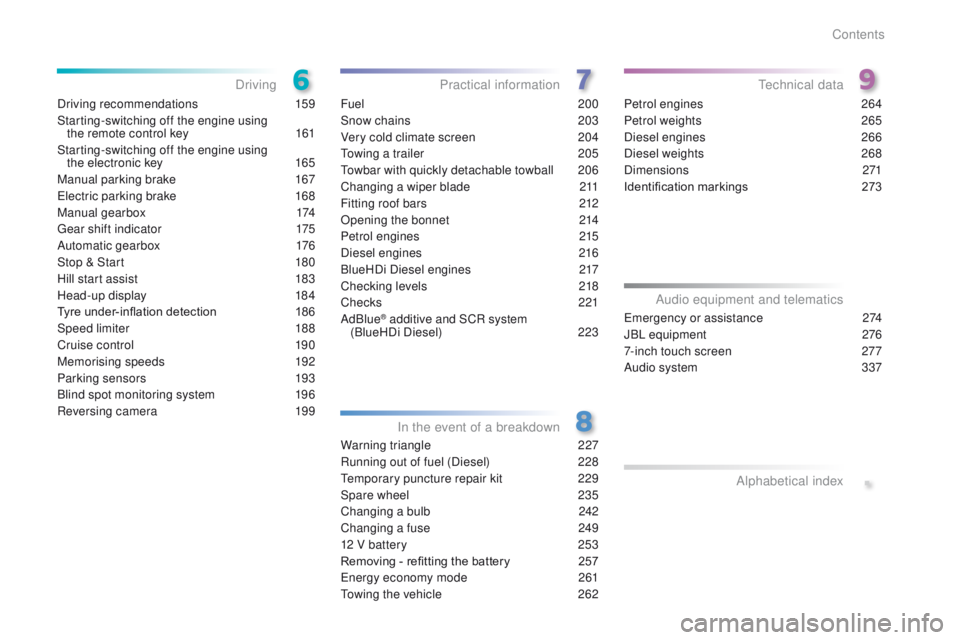
.
Driving recommendations 159
Starting-switching off the engine using the remote control key
1
61
Starting-switching off the engine using the electronic key
1
65
Manual parking brake
1
67
el
ectric parking brake
1
68
Manual gearbox
1
74
ge
ar shift indicator
1
75
Automatic gearbox
1
76
Stop & Start
1
80
Hill start assist
1
83
Head-up display
1
84
Tyre under-inflation detection
1
86
Speed limiter
1
88
Cruise control
1
90
Memorising speeds
1
92
Parking sensors
1
93
Blind spot monitoring system
1
96
Reversing camera
1
99Fuel
200
Snow chains
2
03
Very cold climate screen
2
04
to
wing a trailer
2
05
to
wbar with quickly detachable towball
2
06
Changing a wiper blade
2
11
Fitting roof bars
2
12
Opening the bonnet
2
14
Petrol engines
2
15
Diesel engines
2
16
BlueHDi Diesel engines
2
17
Checking levels
2
18
Checks
221
AdBlue
® additive and SCR system
(BlueHDi Diesel) 2 23
Warning triangle
2
27
Running out of fuel (Diesel)
2
28
te
mporary puncture repair kit
2
29
Spare wheel
23
5
Changing a bulb
2
42
Changing a fuse
2
49
12 V battery
2
53
Removing - refitting the battery
2
57
en
ergy economy mode
26
1
to
wing the vehicle
2
62Petrol engines
2
64
Petrol weights
2
65
Diesel engines
2
66
Diesel weights
26
8
Dimensions
271
Identification markings
2
73em
ergency or assistance 2 74
JBL equipment 2 76
7-inch touch screen
2
77
Audio system
3
37
DrivingPractical information
In the event of a breakdownte chnical data
Audio equipment and telematics Alphabetical index
Contents
Page 13 of 364
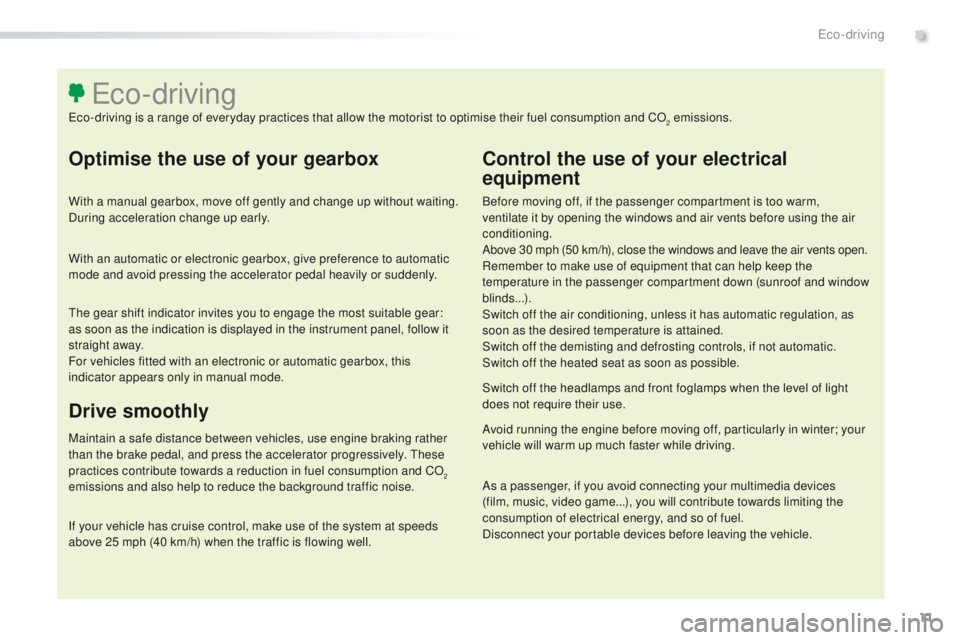
11
Optimise the use of your gearbox
With a manual gearbox, move off gently and change up without waiting.
During acceleration change up early.
With an automatic or electronic gearbox, give preference to automatic
mode and avoid pressing the accelerator pedal heavily or suddenly.
Control the use of your electrical
equipment
Before moving off, if the passenger compartment is too warm,
ventilate it by opening the windows and air vents before using the air
conditioning.
Above 30 mph (50 km/h), close the windows and leave the air vents open.
Remember to make use of equipment that can help keep the
temperature in the passenger compartment down (sunroof and window
blinds...).
Switch off the air conditioning, unless it has automatic regulation, as
soon as the desired temperature is attained.
Switch off the demisting and defrosting controls, if not automatic.
Switch off the heated seat as soon as possible.
Switch off the headlamps and front foglamps when the level of light
does not require their use.
Avoid running the engine before moving off, particularly in winter; your
vehicle will warm up much faster while driving.
As a passenger, if you avoid connecting your multimedia devices
(film, music, video game...), you will contribute towards limiting the
consumption of electrical energy, and so of fuel.
Disconnect your portable devices before leaving the vehicle.
eco-driving
eco-driving is a range of everyday practices that allow the motorist to optimise their fuel consumption and CO2 emissions.
Drive smoothly
Maintain a safe distance between vehicles, use engine braking rather
than the brake pedal, and press the accelerator progressively. th ese
practices contribute towards a reduction in fuel consumption and CO
2
emissions and also help to reduce the background traffic noise.
If your vehicle has cruise control, make use of the system at speeds
above 25 mph (40 km/h) when the traffic is flowing well.
th
e gear shift indicator invites you to engage the most suitable gear:
as soon as the indication is displayed in the instrument panel, follow it
straight away.
For vehicles fitted with an electronic or automatic gearbox, this
indicator appears only in manual mode.
.
Eco-driving
Page 17 of 364
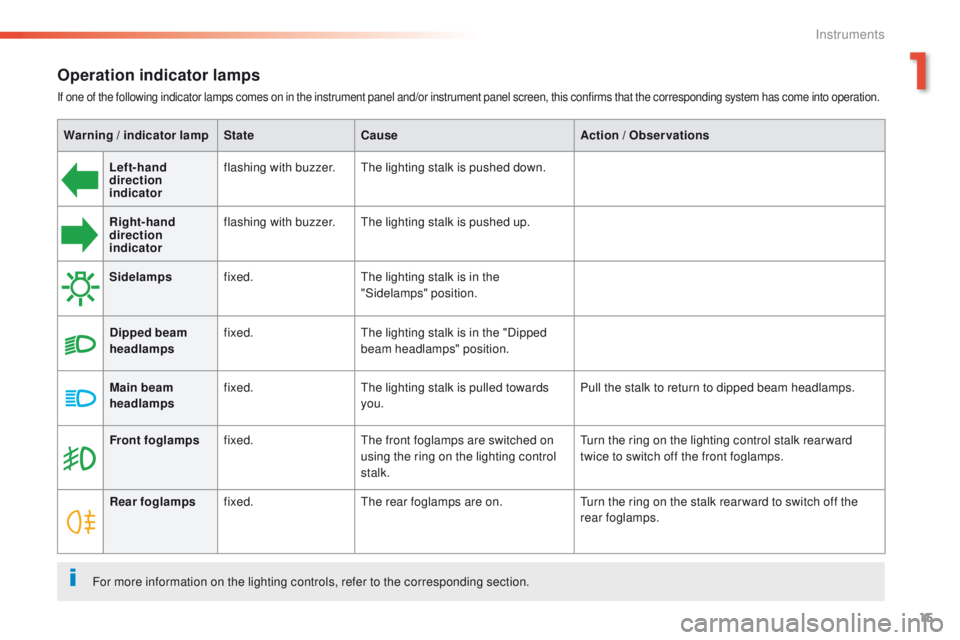
15
Operation indicator lamps
If one of the following indicator lamps comes on in the instrument panel and/or instrument panel screen, this confirms that the corresponding system has come into operation.
Warning / indicator lampStateCause Action / Observations
Left-hand
direction
indicato r flashing with buzzer.
th
e lighting stalk is pushed down.
Right-hand
direction
indicator flashing with buzzer.
th
e lighting stalk is pushed up.
Sidelamps fixed.
th
e lighting stalk is in the
"Sidelamps" position.
Dipped beam
headlamps fixed.
th
e lighting stalk is in the "Dipped
beam headlamps" position.
Main beam
headlamps fixed.
th
e lighting stalk is pulled towards
you. Pull the stalk to return to dipped beam headlamps.
Front foglamps fixed.
th
e front foglamps are switched on
using the ring on the lighting control
stalk.
tu
rn the ring on the lighting control stalk rear ward
twice to switch off the front foglamps.
Rear foglamps fixed.
th
e rear foglamps are on.
tu
rn the ring on the stalk rear ward to switch off the
rear foglamps.
For more information on the lighting controls, refer to the corresponding section.
1
Instruments
Page 51 of 364
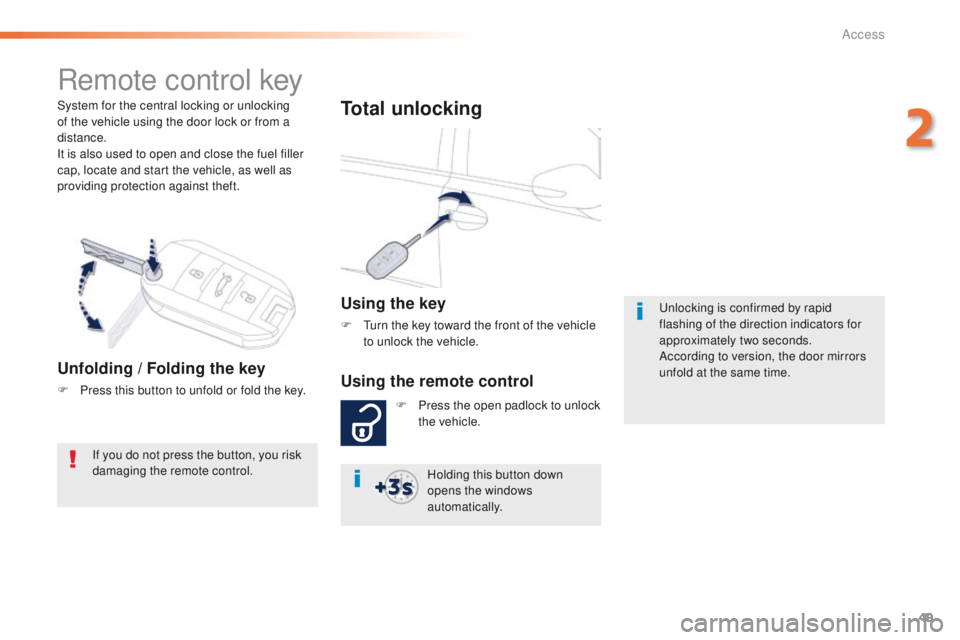
49
System for the central locking or unlocking
of the vehicle using the door lock or from a
distance.
It is also used to open and close the fuel filler
cap, locate and start the vehicle, as well as
providing protection against theft.
Remote control key
Unfolding / Folding the key
F Press this button to unfold or fold the key.
Total unlocking
Using the key
F turn the key toward the front of the vehicle to unlock the vehicle.
If you do not press the button, you risk
damaging the remote control. F
P
ress the open padlock to unlock
the vehicle.
Using the remote control
Holding this button down
opens the windows
automatically.
un
locking is confirmed by rapid
flashing of the direction indicators for
approximately two seconds.
According to version, the door mirrors
unfold at the same time.
2
Access
Page 52 of 364
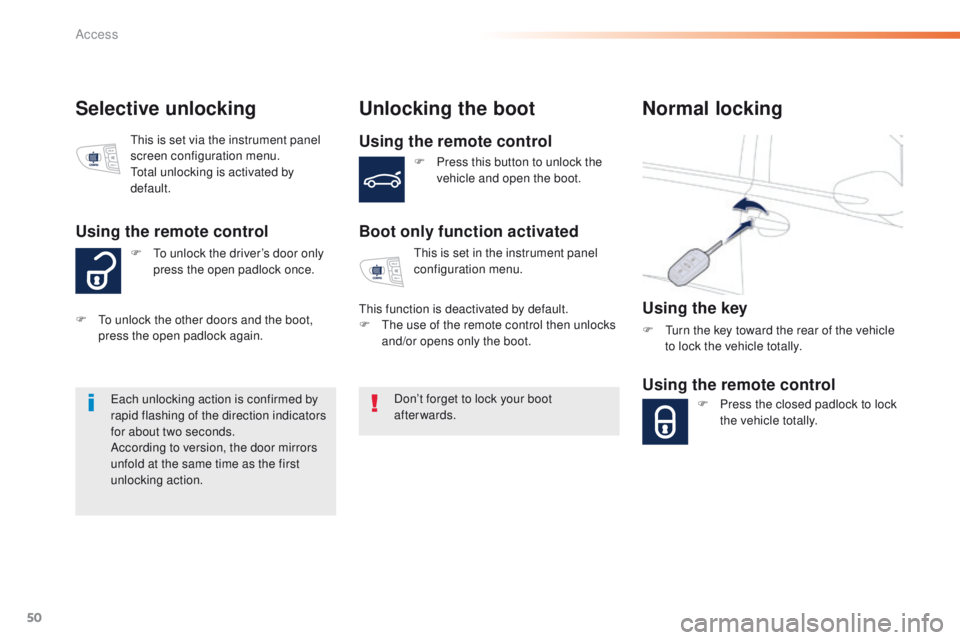
50
Selective unlockingUnlocking the boot
Using the remote control
Boot only function activated
Don’t forget to lock your boot
afterwards.ea
ch unlocking action is confirmed by
rapid flashing of the direction indicators
for about two seconds.
According to version, the door mirrors
unfold at the same time as the first
unlocking action. F
P
ress this button to unlock the
vehicle and open the boot.
th
is is set in the instrument panel
configuration menu.
th
is function is deactivated by default.
F
t
h
e use of the remote control then unlocks
and/or opens only the boot.
Normal locking
Using the key
F turn the key toward the rear of the vehicle to lock the vehicle totally.
F
P
ress the closed padlock to lock
the vehicle totally.
Using the remote control
this is set via the instrument panel
screen configuration menu.
to
tal unlocking is activated by
default.
Using the remote control
F to unlock the driver’s door only press the open padlock once.
F
t
o u
nlock the other doors and the boot,
press the open padlock again.
Access
Page 55 of 364
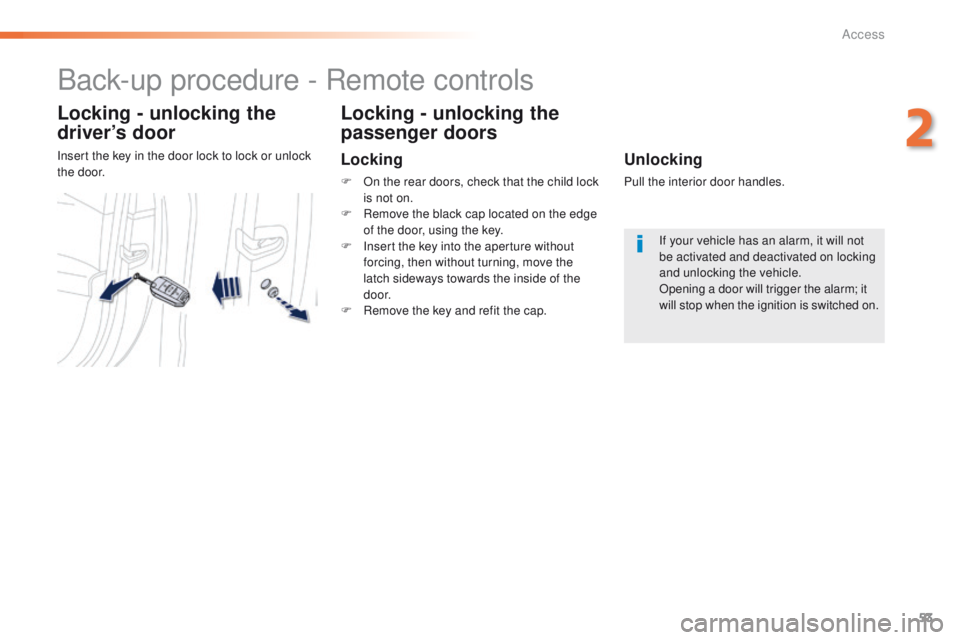
53
Back-up procedure - Remote controls
Locking - unlocking the
driver’s door
Insert the key in the door lock to lock or unlock
the door.
Locking - unlocking the
passenger doors
Locking
F On the rear doors, check that the child lock is not on.
F
R
emove the black cap located on the edge
of the door, using the key.
F
I
nsert the key into the aperture without
forcing, then without turning, move the
latch sideways towards the inside of the
d o o r.
F
R
emove the key and refit the cap.
Unlocking
Pull the interior door handles. If your vehicle has an alarm, it will not
be activated and deactivated on locking
and unlocking the vehicle.
Opening a door will trigger the alarm; it
will stop when the ignition is switched on.
2
Access
Page 64 of 364
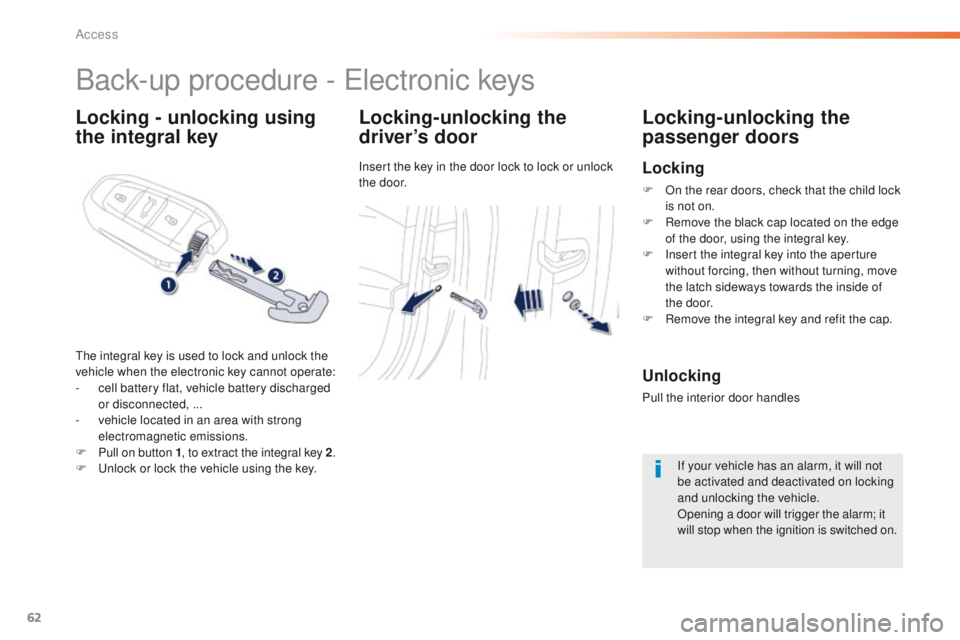
62
Locking - unlocking using
the integral keyLocking-unlocking the
driver’s door
Insert the key in the door lock to lock or unlock
the door.
Locking-unlocking the
passenger doors
Back-up procedure - ele
ctronic keys
the integral key is used to lock and unlock the
vehicle when the electronic key cannot operate:
-
c
ell battery flat, vehicle battery discharged
or disconnected, ...
-
v
ehicle located in an area with strong
electromagnetic emissions.
F
P
ull on button 1 , to extract the integral key
2.
F
u
n
lock or lock the vehicle using the key.
Locking
F On the rear doors, check that the child lock is not on.
F
R
emove the black cap located on the edge
of the door, using the integral key.
F
I
nsert the integral key into the aperture
without forcing, then without turning, move
the latch sideways towards the inside of
the
door.
F
R
emove the integral key and refit the cap.
Unlocking
Pull the interior door handles If your vehicle has an alarm, it will not
be activated and deactivated on locking
and unlocking the vehicle.
Opening a door will trigger the alarm; it
will stop when the ignition is switched on.
Access
Page 70 of 364
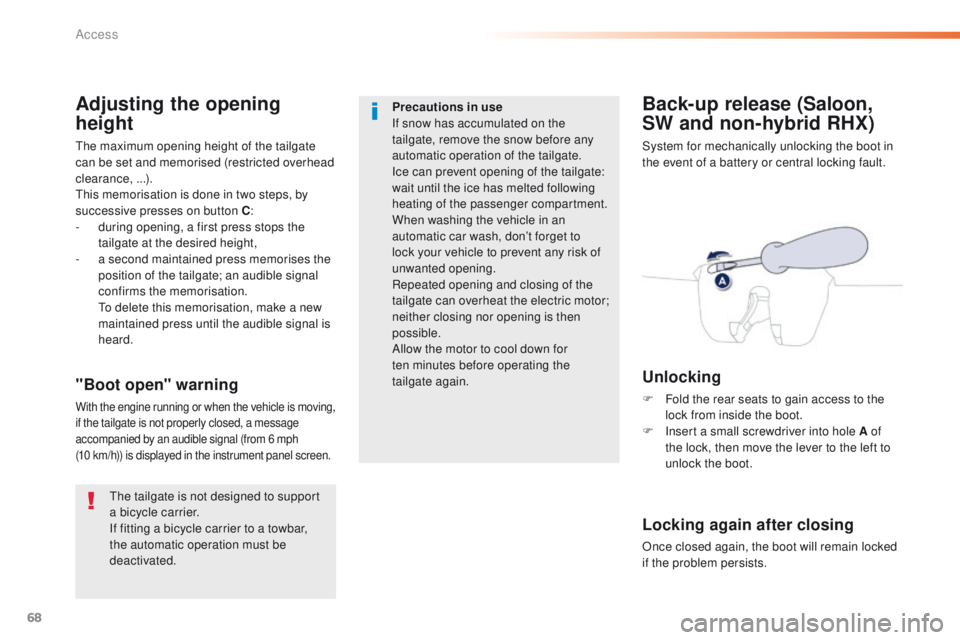
68
Back-up release (Saloon,
SW and non-hybrid RHX)
System for mechanically unlocking the boot in
the event of a battery or central locking fault.
Unlocking
F Fold the rear seats to gain access to the lock from inside the boot.
F
I
nsert a small screwdriver into hole A of
the lock, then move the lever to the left to
unlock the boot."Boot open" warning
With the engine running or when the vehicle is moving,
if the tailgate is not properly closed, a message
accompanied by an audible signal (from 6 mph
(10
km/h)) is displayed in the instrument panel screen.
Locking again after closing
Once closed again, the boot will remain locked
if the problem persists.
Adjusting the opening
height
the maximum opening height of the tailgate
can be set and memorised (restricted overhead
clearance, ...).
th
is memorisation is done in two steps, by
successive presses on button C :
-
d
uring opening, a first press stops the
tailgate at the desired height,
-
a s
econd maintained press memorises the
position of the tailgate; an audible signal
confirms the memorisation.
t
o d
elete this memorisation, make a new
maintained press until the audible signal is
heard.
th
e tailgate is not designed to support
a bicycle carrier.
If fitting a bicycle carrier to a towbar,
the automatic operation must be
deactivated. Precautions in use
If snow has accumulated on the
tailgate, remove the snow before any
automatic operation of the tailgate.
Ice can prevent opening of the tailgate:
wait until the ice has melted following
heating of the passenger compartment.
When washing the vehicle in an
automatic car wash, don’t forget to
lock your vehicle to prevent any risk of
unwanted opening.
Repeated opening and closing of the
tailgate can overheat the electric motor;
neither closing nor opening is then
possible.
Allow the motor to cool down for
ten
minutes before operating the
tailgate again.
Access